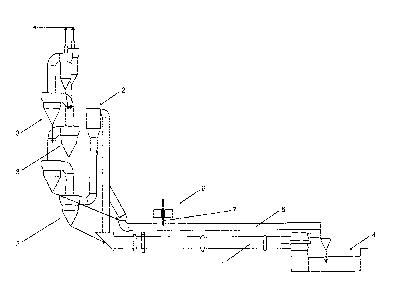Some of the information on this Web page has been provided by external sources. The Government of Canada is not responsible for the accuracy, reliability or currency of the information supplied by external sources. Users wishing to rely upon this information should consult directly with the source of the information. Content provided by external sources is not subject to official languages, privacy and accessibility requirements.
Any discrepancies in the text and image of the Claims and Abstract are due to differing posting times. Text of the Claims and Abstract are posted:
| (12) Patent: | (11) CA 2697847 |
|---|---|
| (54) English Title: | DEVICE FOR RESTRICTING HOT, DUST-LADEN GAS FLOWS |
| (54) French Title: | DISPOSITIF D'ETRANGLEMENT DE FLUX GAZEUX CHAUDS, CHARGES EN POUSSIERES |
| Status: | Expired and beyond the Period of Reversal |
| (51) International Patent Classification (IPC): |
|
|---|---|
| (72) Inventors : |
|
| (73) Owners : |
|
| (71) Applicants : |
|
| (74) Agent: | MARKS & CLERK |
| (74) Associate agent: | |
| (45) Issued: | 2016-01-26 |
| (86) PCT Filing Date: | 2008-08-21 |
| (87) Open to Public Inspection: | 2009-03-05 |
| Examination requested: | 2013-07-31 |
| Availability of licence: | N/A |
| Dedicated to the Public: | N/A |
| (25) Language of filing: | English |
| Patent Cooperation Treaty (PCT): | Yes |
|---|---|
| (86) PCT Filing Number: | PCT/IB2008/002172 |
| (87) International Publication Number: | WO 2009027787 |
| (85) National Entry: | 2010-02-25 |
| (30) Application Priority Data: | ||||||
|---|---|---|---|---|---|---|
|
In a device for restricting hot, dust-laden gas flows and, in
particular, dust-laden hot cooling air from clinker coolers (4)
in a tertiary air duct (5) of a clinker kiln, the restrictor (6)
is formed by segments (8) which are displaceable transversely to
the direction of flow in a duct (5) and which are connectable
with one another.
L'invention concerne un dispositif d'étranglement de flux gazeux chauds, chargés en poussières, notamment d'air de refroidissement chauds, chargés en poussières, sortant de refroidisseurs à clinker (4) dans un canal d'air tertiaire (5) d'un four à clinker. Selon l'invention, le dispositif d'étranglement (6) est formé de segments (8) mobiles dans un canal (5) transversalement au sens d'écoulement, ces segments pouvant être reliés entre eux.
Note: Claims are shown in the official language in which they were submitted.
Note: Descriptions are shown in the official language in which they were submitted.

2024-08-01:As part of the Next Generation Patents (NGP) transition, the Canadian Patents Database (CPD) now contains a more detailed Event History, which replicates the Event Log of our new back-office solution.
Please note that "Inactive:" events refers to events no longer in use in our new back-office solution.
For a clearer understanding of the status of the application/patent presented on this page, the site Disclaimer , as well as the definitions for Patent , Event History , Maintenance Fee and Payment History should be consulted.
| Description | Date |
|---|---|
| Time Limit for Reversal Expired | 2018-08-21 |
| Letter Sent | 2017-08-21 |
| Grant by Issuance | 2016-01-26 |
| Inactive: Cover page published | 2016-01-25 |
| Inactive: Final fee received | 2015-11-18 |
| Pre-grant | 2015-11-18 |
| Notice of Allowance is Issued | 2015-06-05 |
| Letter Sent | 2015-06-05 |
| Notice of Allowance is Issued | 2015-06-05 |
| Inactive: Approved for allowance (AFA) | 2015-05-11 |
| Inactive: Q2 passed | 2015-05-11 |
| Amendment Received - Voluntary Amendment | 2015-01-22 |
| Inactive: S.30(2) Rules - Examiner requisition | 2014-07-25 |
| Inactive: Report - QC failed - Minor | 2014-07-14 |
| Amendment Received - Voluntary Amendment | 2014-05-29 |
| Letter Sent | 2013-08-15 |
| Request for Examination Requirements Determined Compliant | 2013-07-31 |
| All Requirements for Examination Determined Compliant | 2013-07-31 |
| Request for Examination Received | 2013-07-31 |
| Inactive: Cover page published | 2010-05-12 |
| Inactive: Notice - National entry - No RFE | 2010-05-03 |
| Inactive: Office letter | 2010-05-03 |
| Letter Sent | 2010-05-03 |
| Inactive: Applicant deleted | 2010-05-03 |
| Inactive: First IPC assigned | 2010-04-29 |
| Inactive: IPC assigned | 2010-04-29 |
| Inactive: IPC assigned | 2010-04-29 |
| Inactive: IPC assigned | 2010-04-29 |
| Application Received - PCT | 2010-04-29 |
| National Entry Requirements Determined Compliant | 2010-02-25 |
| Application Published (Open to Public Inspection) | 2009-03-05 |
There is no abandonment history.
The last payment was received on 2015-08-05
Note : If the full payment has not been received on or before the date indicated, a further fee may be required which may be one of the following
Please refer to the CIPO Patent Fees web page to see all current fee amounts.
| Fee Type | Anniversary Year | Due Date | Paid Date |
|---|---|---|---|
| Registration of a document | 2010-02-25 | ||
| Basic national fee - standard | 2010-02-25 | ||
| MF (application, 2nd anniv.) - standard | 02 | 2010-08-23 | 2010-07-30 |
| MF (application, 3rd anniv.) - standard | 03 | 2011-08-22 | 2011-07-27 |
| MF (application, 4th anniv.) - standard | 04 | 2012-08-21 | 2012-07-31 |
| Request for examination - standard | 2013-07-31 | ||
| MF (application, 5th anniv.) - standard | 05 | 2013-08-21 | 2013-08-02 |
| MF (application, 6th anniv.) - standard | 06 | 2014-08-21 | 2014-08-15 |
| MF (application, 7th anniv.) - standard | 07 | 2015-08-21 | 2015-08-05 |
| Final fee - standard | 2015-11-18 | ||
| MF (patent, 8th anniv.) - standard | 2016-08-22 | 2016-08-15 |
Note: Records showing the ownership history in alphabetical order.
| Current Owners on Record |
|---|
| HOLCIM TECHNOLOGY LTD. |
| Past Owners on Record |
|---|
| URS GASSER |